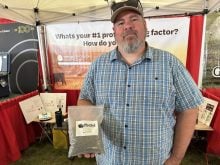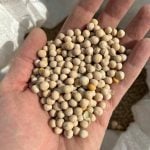A new online tool developed by researchers at the University of Saskatchewan could help farmers in Western Canada make more accurate on-farm fertilizer decisions.
The Prairie Nutrient Removal Calculator was officially released in early May. It provides up-to-date nutrient removal rates for 15 different crops commonly grown on the Canadian Prairies.
The calculator is the culmination of three years of work led by Fran Walley and Rich Farrell, a pair of researchers and soil scientists at the U of S.
Read Also

Claas brings 1000 Series SP forage harvesters to Canada
In mid-August, Claas unveiled its new line of Jaguar forage harvesters at an event in Visalia, California, deep in the heart of that state’s dairy region.
Funding for the project was provided by the Western Grains Research Foundation, Alberta Wheat Commission, Prairie Oat Growers Association, Saskatchewan Canola Development Commission, Saskatchewan Flax Development Commission and Saskatchewan Wheat Development Commission.
While a nutrient removal calculator isn’t a new concept, Walley says its design, specifically for Prairie farmers, sets this one apart.
“If you look at some of the other online calculators, they’re really great. The International Plant Nutrient Institute has a really good one, for example. But if you dig around on their website, you realize that the data for (that) calculator came from China and India and not from Western Canada.”

As part of the project, Walley and Farrell enlisted the help of a small army of on-ground volunteers in Alberta, Saskatchewan and Manitoba to collect more than 2,200 grain and biomass samples from more than 300 commercial farms between 2020 and 2022.
To determine nutrient removal from the soil, seed samples were collected at harvest along with information on crop yield. They were then dried, crushed and analyzed for the presence of macronutrients including nitrogen, phosphorus, potassium and sulphur.
Walley and Farrell say collecting a large number of samples from a wide variety of locations was critical to the project’s success.
“We wanted to make sure we were truly representing Western Canada so we needed a lot of samples, is what it came down to,” Walley says.
“The more samples you get, the closer you come to a true average or value that represents what’s out there,” adds Farrell.
Farrell says the project fostered a sense of collaboration among participants. That included regional agronomists in Saskatchewan and Alberta, whose sample collection efforts were co-ordinated by Lyle Cowell of Nutrien Ag Solutions and field staff in Manitoba who were organized by John Heard with Manitoba Agriculture.
Farrell also credits U of S postdoctoral fellow Gazali Issah for his help in logging and analyzing the hundreds of samples.
He adds it was critically important to have commercial farms involved in developing the calculator. “We didn’t want to be doing small plot research demonstrations. We wanted to be out in commercial fields because that reflects what’s really happening out there.”

Simple to use
The Prairie Nutrient Removal Calculator is available online and free of charge at prairienutrientcalculator.info.
It’s simple to use. A user chooses one of three crop types in the top box on the left side of the screen and then chooses a specific crop from the list provided.
From there, the user enters the bushels per acre that were harvested or are expected to be harvested in a field on the right side of the screen. The calculator automatically estimates the amount of nitrogen, phosphorus, potassium and sulphur removed from the soil by the harvested crop.
For example, a harvest of 40 bushels of canola will be shown to remove 75 pounds per acre of nitrogen, 31 pounds of phosphorus, 15 pounds of potassium and nine pounds of sulphur based on the 75th percentile of the survey data for each nutrient.
The calculator can be used for barley, corn, durum, oats, spring wheat, winter wheat, canola, flax, mustard, soybean, chickpea, dry bean, faba bean, lentil and pea.
Farrell says the crop selections were made based on “the crops that we knew a lot of people were growing and we would be able to get enough data to do this with.”
A priority throughout the design phase was ensuring the calculator was accessible and easy to use.
“The more complicated you make these things, the less likely people are to use them,” says Farrell. “The idea is you want to make it straightforward, so you don’t have to do the calculations yourself. The calculator does everything for you.”
While the calculator provides valuable data for managing crop inputs, Walley stresses it doesn’t replace the need for regular soil testing but is another tool to help agronomists and farmers better analyze soil test reports and make nutrient adjustments to maintain or build soil nutrient levels.
“This doesn’t replace good soil testing. It’s simply another piece of information that can help an agronomist or a farmer make fertilizer management decisions,” she says, adding the calculator only tells the user what is coming off the field, not what is required to grow a crop.
“Fertilizer is becoming increasingly expensive. These are decisions farmers have to make and agronomists have to make and the more information that is available to them (to) make those decisions, the better.”
Walley says the calculator incorporates the latest data available to farmers and agronomists. Some other similar calculators are based on figures from 30 or 40 years ago and don’t reflect many of the changes since then in terms of varieties, management practices and cropping rotations.
Micronutrients
The calculator is one of the first online calculators for Western Canada to include micronutrients including copper, boron and zinc.
“There are increasing questions about micronutrients, and this was an opportunity to get a handle on what is the micronutrient removal,” Walley says.
“We’re not suggesting that people need to be applying micronutrient fertilizer, but as yield potential and yield expectations increase and the intensification of farming practices continue, we will likely have to be thinking more about micronutrients in the future. Keeping an eye on that is probably a good idea.”
Farrell says early feedback has been largely positive and he is optimistic it will be well used as more farmers and agronomists learn about it.
















